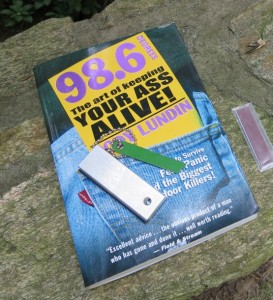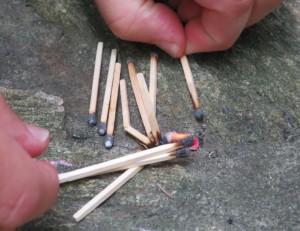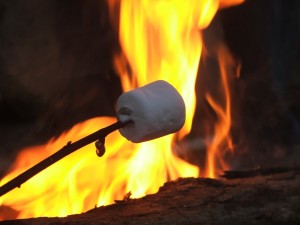 I hand my 10 year old the magnesium fire starter kit.
I hand my 10 year old the magnesium fire starter kit.
“You’re in charge of making a fire. The back of the package has instructions on how to use it. Daddy finally caught a fish, but unless we want to eat it raw, we need a fire…”
We got turned around this morning, in the thick fog. We waited for hours, but nobody came looking for us. Then it started pouring. Eight hours of near constant rain. Now it’s getting dark and the temperature has dropped into the 40s. We are hungry, tired and soaked to the bone. I keep wondering if that rustling I hear in the bushes is a bear. I talk loudly, hoping he’s more scared of us than we are of him. We really need a fire…
——————
We’re 2 weeks away from leaving for our adventure trip to Alaska. Hiking. Bear watching. Sea kayaking. Wilderness camping. 16 days of adventures.
We’ve bought most of the stuff on the gear list for the trip: the quick dry pants, the kayaking gloves, the headlamps, the bear bells and the bug spray. And most of the 27 other essentials the outfitters’ lists identified.
But in my mind, I’ve just added one more: emergency kit.
Of COURSE everything will be fine and we’ll never need it. But it’ll make me feel better to have it.
Just in case.
I’m big on what if scenarios.
So I survey all the cool little gadgets I have been accumulating over the years. Mini LED lights, microfiber towels, fire starters, compass zipper pulls, solar panel rechargeable flash lights. Most of them in their original packaging. I even have one of those ready-made kits, the ones that have everything in one handy pack. That would be easy and convenient. A smaller pack size too. Waterproof until you rip them open.
“You’re going to trust your life and the lives of your son and your husband to a pre-packed kit made in China, especially one that you have never opened and inspected? A kit made with the cheapest components the manufacturer can get away with, knowing that most of their kits will never see the light of day? The same one-size-fits all kit sold to people going on a hiking trip in the Sonoran Desert, as well as to people going on a kayaking trip in the rainforests of Southeast Alaska? Seriously?!”
“But it’s waterproof! And if I open it now, it won’t be waterproof any more.”
“Really?! You’re going to bring this with you and not open it to keep it waterproof and when the emergency hits, you yell ‘Surprise!’ as you tear off the top??”… Hmmm, maybe NOT. I really don’t want to take myself out of the gene pool.
 A few years ago, I read Cody Lundin’s hilarious book on surviving the unexpected: 98.6 degrees. The Art of Keeping Your Ass Alive. He makes that point very clearly: if you trust your life to a kit you have not worked with, whose components you have not tested, you’re not smart. “It’s the surest way to make sure your gene pool ends with you.” An example of natural selection at work…
A few years ago, I read Cody Lundin’s hilarious book on surviving the unexpected: 98.6 degrees. The Art of Keeping Your Ass Alive. He makes that point very clearly: if you trust your life to a kit you have not worked with, whose components you have not tested, you’re not smart. “It’s the surest way to make sure your gene pool ends with you.” An example of natural selection at work…
Call it vanity, but I would rather be remembered for my smarts in bringing an emergency kit AND knowing how to use the stuff in it, than taking myself out of the gene pool.
Inconveniently, when you put your own thing together, you actually have to think about what you might need: climate, area, activities, experience level (uh, novice? Novice +??). – My last wilderness camping in Alaska was 26 years ago, and the only thing I have done since then that pertains in any way, was a class in primitive skills last year, where we learned to make fire with a bow drill and ate pack rat and roasted crickets (don’t ask). Bottom line, I have next to no experience with modern equipment since primitive skills are for long term survival, and “living off the land”. I would certainly hope that if we do get lost in Alaska, we’ll be found before the granola bars run out.
For years, I have had these super hero dreams where I quietly rescue people (no cape; think Clark Kent, not Superman) and then just walk away once they’re safe. I can see it now: the emergency hits, everybody panics, but I whip out my emergency kit (“Oh THAT is why mom’s backpack was so heavy and bulky!”) and masterfully build a shelter, make a fire and catch dinner. – Um, yeah, 14 days to liftoff. Strike the shelter and the fishing.
Fire. Fire is doable.

With that in mind, I line up my fire starting options: the storm and weatherproof matches, the magnesium fire striker kit, some little orange plastic thingy with wooly braids. Discovery time!
For a moment, become the meanest mother ever when I rip my son away from his baseball game on TV and tell him and my husband to come out to the back yard for a fire demo. They usually scoff at my “reeeesearch” (eye roll) and want to just go with the flow. “We don’t need a drill.” “Of course I know how to use matches.” “Why can’t YOU just do it?”
I’m putting my foot down on this one. “Because everyone going on this trip needs to know how to make a fire in an emergency. Period.”
I bring out the cheap kitchen matches so we can practice on those first. (Did you know the kitchen matches are “safety” matches that will only ignite when you strike them on the sandpaper-y striker on the side of the box? And survival matches are strike-anywhere matches with a 2-colored head, where the action of striking brings the 2 chemicals into contact and ignites the flame?) I ask my son what we need to make a fire. “Little sticks.” True, but what I’m trying to get at is that we need tinder. Something very small, very dry, that will ignite almost instantly. I remind him of starting BBQ fires and how sticks don’t burn well when you first start out.
Deron is better at “learning by doing” than learning from books. Or learning from other people’s mistakes. Or learning from anything I say. In other words, telling him will do nothing. (Come to think of it, he’s remarkably similar to my husband in that regard.)
So I need to let him do things. Let him fail and figure out why and then do better.
I suck at that. Keeping my mouth shut and letting him fail is really hard for me. I actually read instruction booklets. Yes. I do. And I read Amazon reviews and try to remember tips and tricks from other reviewers. Or watch a YouTube video. I’m a geek. But loveable. Mostly.
 I tell him to light the bits of dry grass and leaves he has gathered with a kitchen match.
I tell him to light the bits of dry grass and leaves he has gathered with a kitchen match.
Of course, the wind blows out the match almost instantaneously.
He lights another match. Again, it gets blown out.
Finally he realizes that he needs to shield the match from the wind. He turns and bends down a little but does a half-assed job and the match goes out again.
“Our waterproof match safe holds 12 matches. We have now wasted 3 of them. Let’s make the next one count.” Nothing like mom cranking up the pressure.
“Which direction is the wind coming from?” Shoulder shrug. How does he not know this? We’re in a garden surrounded by tall trees and shrubs, so maybe it’s hard to tell. But still… I have him lick his finger and hold it up into the wind.
“Do you feel one side getting cold? That’s the side that is being cooled by the wind. You need keep your match and your tinder low to the ground and use your body to shield it”.
Two more matches and we finally have fire! Of course that was just the practice run to the practice run: I’m not taking regular matches on the kayaking trip because they’re useless when wet; also useless once you lose or tear, or wet the box with the striker paper. Don’t get me wrong, I’ll happily accept a match book in the wilderness over no matches any day, but I’m going by the Peter Principle that anything that can go wrong will go wrong, at the most inconvenient time. So, I’d rather have options beyond the matchbook from RuthAnn’s 24 hour diner.
![IMG_0252[1]](https://feelthesparkinside.com/wp-content/uploads/2015/08/IMG_02521-300x225.jpg) Ok, we’re good on tinder and sheltering your fire from wind.
Ok, we’re good on tinder and sheltering your fire from wind.
Now, on to the real deal: I hand him the magnesium fire striker kit, just like in my scenario above.
The pack consists of a silver block with a thin black rod along one of the edges, and a stiff green strip of metal, with a serrated edge on the front and along half of one long side. You’re supposed to shave off some of the magnesium onto your tinder and then ignite the shavings with a spark you create by hitting the shaving blade against the flint. I’ve never done this either. Just read the instructions (no reviews, no YouTube).
![IMG_0256[1]](https://feelthesparkinside.com/wp-content/uploads/2015/08/IMG_02561-300x225.jpg)
I watch Deron for a while trying to shave pieces off the rod. I take a deep breath and force myself to be quiet as he nicks the flint rod, trying to “shave.” Finally, when nothing happens, I have him read the instructions again and identify all three components: magnesium, flint, and striker. Eventually it dawns on him that the silver block is the magnesium. He starts again and little silver flakes gather on our tinder! Striking sparks off the rod is much harder. Initially only my husband can do it, then Deron and I catch on as well. It’s all in the angle and in how hard you strike the rod with it.
The catch is that the sparks happen where you strike, up in the air, not near the tinder. None of the sparks even come close. So we hold the flint lower, closer to the tinder. Now almost every time we strike, we hit the tinder with our hands: the shavings disappear into the tinder, fall through to the ground. We all try for about 10-15 minutes. Really frustrating. Raw salmon and wet clothes again tonight!
I pull out my secret weapon: a ziplock with dryer lint. Yes, lint. Recommended by a bunch of reviewers on Amazon. (Have I mentioned that I LOVE the internet?!) I shape some of the lint into a little nest and it works much better in collecting the shavings on the surface, even if we bump it. My husband and my son now alternate. I hold the tinder in place; they spark. Still no go. Family of three found after 4 days in the wilderness, severely hypothermic…
“Aren’t you glad you’re trying this after breakfast in the comfort of our sunny backyard, rather than opening the package in the woods, in the rain, hungry and tired and so cold that you’re losing fine motor control in your fingers?” – Just trying to make a point here…
Deron keeps at it, with tenacity, swearing like a sailor every time he accidentally hits the tinder and pushes it out of the way, every time the serrated edge bites into his fingers on the strike. And I hear him muttering: “We’re gonna die. We’re just gonna f*ing die. We’ll never light this fire!”
“Well, you COULD come out here for an hour every day before we leave and practice this instead of watching Spongebob!”
Yeah, right.
Before we all get completely frustrated, I open up the little SOL fire starter kit my husband got me for my birthday a few years ago. There’s an inch-long orange plastic piece with a wheel (think Bic lighter without the fuel or the tank), and 4 short white fabric braids that are supposedly waterproof and act as tinder. I have never been particularly good with lighters but scrolling the wheel in the direction of the arrow gets me sparks right away. Wow!
Deron immediately commandeers the lighter and easily sets his magnesium shavings on lint on fire. Victory! Then we try just sparks on grass tinder. Works too. And the little braids work like a charm once you pull them apart. This one is a winner!
Before I completely lose my two guys to the magic of feeding the fire, I hand them the weatherproof matches for one last test.
![IMG_0282[1]](https://feelthesparkinside.com/wp-content/uploads/2015/08/IMG_02821-300x225.jpg)
Compared to kitchen matches, they are gigantic, wax coated, and have some amazing chemical ingredient that makes them not go out in the wind – or the water, for that matter. Deron was reading this on the packaging and of course he wants to drown one.
He runs back into the house and gets a cup. Then we each light one match and blow on it, count how long it burns, and finally dunk it in water and pull it back out – only to find it’s still burning. Amazing. Then Deron sacrifices a fourth match in the name of science because he wants to keep one match in the cup until it’s completely burned up. Fine. Learning by doing. The burning match is creating an effect that makes it appear as if the water were boiling. Doesn’t really heat the water noticeably, but looks very cool. Another winner. The only disadvantage is that these suckers are huge. Long. Thick. Hard to pack. Whatever. Clearly the easiest way to get a fire started.
Some books recommend including as many as 3 or 4 different ways of making fire in your kit. I’ll be packing some lint and a few of the waterproof braids, along with weatherproof matches, and the SOL “lighter”. Easy to operate, good for 5,000 sparks, small and light. Now I just need to figure out how to wear it around my neck.
Yup. I figure it’s like what they say about cameras: “what’s the best camera?”– “The one you have on you.” …Your emergency kit is only going to help if you have it on you when the emergency happens, right? So I figure, I’ll hang that lighter around my neck and keep it on my person. And if no emergency happens, I can still surprise and delight the family with toasted marshmallows on a hike somewhere …

![IMG_0267[1]](https://feelthesparkinside.com/wp-content/uploads/2015/08/IMG_02671-300x225.jpg)
![IMG_0274[1]](https://feelthesparkinside.com/wp-content/uploads/2015/08/IMG_02741-300x225.jpg)
![IMG_0277[1]](https://feelthesparkinside.com/wp-content/uploads/2015/08/IMG_02771-300x225.jpg)
![IMG_0443[1]](https://feelthesparkinside.com/wp-content/uploads/2015/08/IMG_04431-300x225.jpg)
![IMG_0450[1]](https://feelthesparkinside.com/wp-content/uploads/2015/08/IMG_04501-300x225.jpg)
